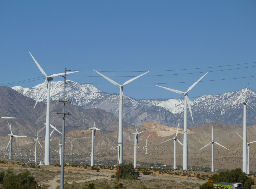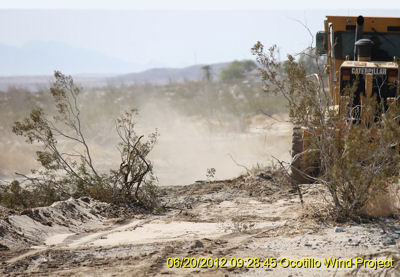| Wind Watch is a registered educational charity, founded in 2005. |
Interior Dept. report slams BLM for poor monitoring, lack of financial accountability at wind and solar projects on public lands
Credit: By Miriam Raftery | East County Magazine | eastcountymagazine.org 23 June 2012 ~~
A scathing new report by the U.S. Department of Interior’s Inspector General highlights “significant failures” by the federal Bureau of Land Managment in its stewardship over more than 30,000 wind energy right-of-way (ROW) acres and another 31,000 acres of solar energy ROW sites. View the complete report at www.doioig.gov/images/stories/reports/pdf/CR-EV-BLM-0004-2010Public.pdf.
In addition, the report exposed “weakness in financial accountability and resource protection including obligations to protect the Government’s financial interest by collecting rental revenues, managing the bond process, and by appropriate monitoring and enforcing ROW requirements.”
The BLM is poised to add another 21 million acres identified with wind energy development potential and over 20 million acres for potential solar energy facilities, raising serious concerns over enforcement of mitigation requirements for impacts on public lands.

BLM failed to collect adequate bonds for Palm Springs wind projects
For example, in Palm Springs the BLM failed to adequately bond four wind projects, including one with 460 turbines “leaving BLM at risk to future liabilities for land reclamation and the potential damage to natural resources,” the report stated.
The report is damning when it comes to BLM enforcement of mitigation requirements.
“Our review of wind project files revealed very little inspection documentation for wind projects and no monitoring plans,” the report found. “One BLM field manager told us that wind projects ‘run themselves’ and do not have many issues requiring monitoring.”

Dust has been an ongoing problem during construction of Ocotillo wind project; photo by Jim Pelley
In Ocotillo, where the Ocotillo Express wind project is under construction, residents have repeatedly complained about a lack of BLM monitors and have documented numerous problems on video and with photos, ECM has learned. These include lack of adequate dust controls (which eventually led to enforcement action by Imperial Valley’s air pollution control board, after citizen complaints), apparent violations of water use agreements and failure to obtain permits from the Army Corps of Engineers before drastically altering drainage in the area.
The federal report concluded from its fieldwork that “continued monitoring is important to ensure the project site is properly maintained and safe.” Monitoring activities can identify incidents such as collapsed wind turbines, bird deaths, damage from fallen meteorological towers, and oil leaks from hydraulic systems.

Collapsed turbine went unreported in Wyoming
The Interior Department’s inspectors found an unreported collapsed wind turbine at a BLM wind project in Wyoming in 2010. The BLM learned of the collapse only after photos were posted on Facebook. The ownership of the project had changed hands and new owners claimed they were unaware of reporting requirements.
Collapse was found to be due to a hydraulic system failure during a power outage, combined with high winds that overstressed the turbine. Leakage was caused by a faulty O-ring. Earlier inspection might have identified the leak and prevented collapse of the multi-ton turbine.
The report further criticized the BLM for using third-party contracting for monitoring with no controls or oversight, as well as using a non-competitive bidding process, further costing taxpayers money.
The report made numerous recommendations for improvement.
It also includes contact information for the public to report fraud, waste and mismanagement to the Inspector General’s staff at the Department of the Interior: Visit www.doioig.gov
Call the 24-hour free number to report waste, fraud and abuse at 800-424-5081
Send a report by fax to 703-487-5402
File a report by mail with the U.S. Dept. of Interior, Office of Inspector General, Mail Stop 4428 MIB, 1849 C St. NW, Washington DC 20240.
This article is the work of the source indicated. Any opinions expressed in it are not necessarily those of National Wind Watch.
The copyright of this article resides with the author or publisher indicated. As part of its noncommercial educational effort to present the environmental, social, scientific, and economic issues of large-scale wind power development to a global audience seeking such information, National Wind Watch endeavors to observe “fair use” as provided for in section 107 of U.S. Copyright Law and similar “fair dealing” provisions of the copyright laws of other nations. Send requests to excerpt, general inquiries, and comments via e-mail.
| Wind Watch relies entirely on User Contributions |
 (via Stripe) |
 (via Paypal) |
Share:

